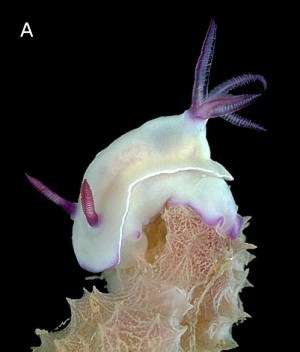
Hypselodoris bullocki
(Collingwood, 1881) - Page 1
Order: NUDIBRANCHIA
Suborder: DORIDINA
Family: Chromodorididae
DISTRIBUTION
Tropical western Pacific and eastern Indian Ocean.
PHOTO
A, Koumac, New Caledonia, October 1993, 18mm long alive, feeding on sponge. B,C, Pelorus Is, Queensland, June 1983. D, Darwin, Northern Territory, Australia, June 1987. PHOTOS: Bill Rudman.
E, Heron Is, Queensland, January 1983. PHOTO: Geoff Avern.
See Page 2., Page 3.
See Hypselodoris apolegma, which may be a colour form.
Originally described from the South China Sea, this species is found in the western Pacific as far south as southern Queensland. It is also found in north western Australia and Thailand. It ranges in colour from a pale straw, or even white background to a deep purplish pink. There is usually a thin opaque white line at the mantle border, but some specimens have a reddish purple border. Typically the gills and rhinophores are yellow or orange with a basal pink or purplish band. In anatomical studies I have been unable to find any consistent differences to show that differing colour patterns represent differnet species. Unpublished studies of the anatomy show that this species should probably be placed in the genus Risbecia.
Reference:
• Collingwood, C. (1881) On some new species of nudibranchiate mollusca from the eastern seas. Transactions of the Linnean Society of London, Zoology, 2: 123-140.
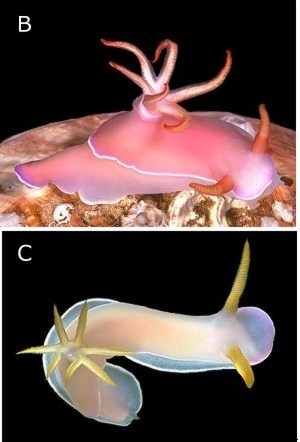
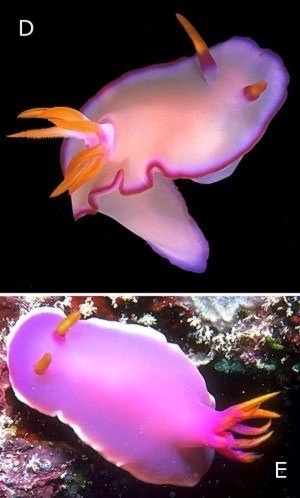
Rudman, W.B., 1999 (May 6) Hypselodoris bullocki (Collingwood, 1881) - Page 1. [In] Sea Slug Forum. Australian Museum, Sydney. Available from http://www.seaslugforum.net/find/hypsbull
Related messages
Re: Hypselodoris cf. bullocki
July 27, 2006
From: Mike Krampf
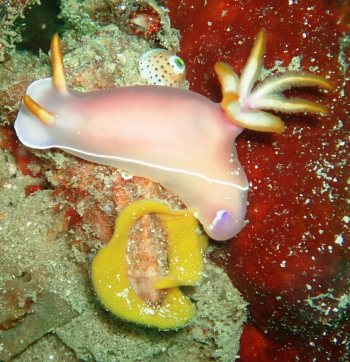
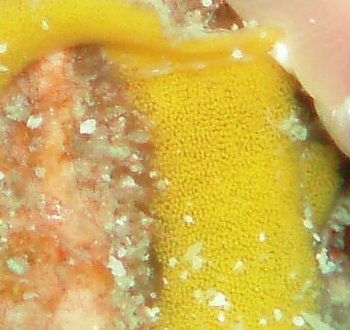
Concerning message #2073:
I was looking through some older messages and found this one where you were requesting some photos of Hypselodoris bullocki with some eggs. Here are some pics that I took off Tioman Island, Malaysia. The eggs shown alone were a few feet away from the other picture.
Locality: Tioman Island, 40 feet, Malaysia, South China Sea, 16 June 2006, Reef. Length: 3-4 cm. Photographer: Mike Krampf.
Hope this helps.
Mike
mtkrampf@yahoo.com
Krampf, M., 2006 (Jul 27) Re: Hypselodoris cf. bullocki. [Message in] Sea Slug Forum. Australian Museum, Sydney. Available from http://www.seaslugforum.net/find/17202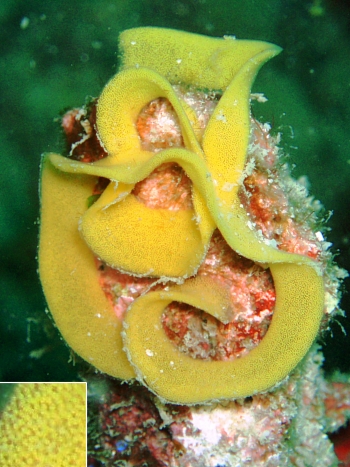
Dear Mike,
Thanks for these. I'm always on the lookout for photos of animals laying eggs. It is always a useful bit of information to have when comparing different species or possible different species. These egg ribbons certainly look like others we now have of this species.
Best wishes,
Bill Rudman
Hypselodoris cf. bullocki
March 13, 2000
From: Erwin Koehler
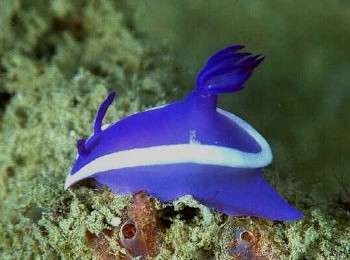
Hi Bill,
This one is by Giovanni Marola email: marola@iet.unipi.it
The picture was made at Lankayan Island, eastern Sabah (Malaysia),
February 12, 2000 at a depth of about 18-24 meters, size not recorded.
Can you identify it?
Erwin
Medslugs.Koehler@t-online.de
Koehler, E., 2000 (Mar 13) Hypselodoris cf. bullocki. [Message in] Sea Slug Forum. Australian Museum, Sydney. Available from http://www.seaslugforum.net/find/2073Dear Erwin,
All I can say is that it is probably part of the H. bullocki group. I have looked at the radula of most of the colour forms (but not the blue one) and can find no differences. I don't know if that means I should look more diligently, or if it is a very variable species or what. Any clues, like photos of egg masses and sponge food etc, of any colour forms would be of great interest.
Best wishes,
Bill Rudman.
Impossible to keep in reef tank?
February 1, 2000
From: Chris Elmore
I recently purchased a Nudibranch from a local pet store in Charlotte, N.C. It is purple with a white border, has yellow horns and yellow frilly bits. I have since been told they are impossible to keep and can wipe out my tank. Can you elaborate on this? Thanks!
Chris Elmore
Chris_Elmore@isc-mail.com
Elmore, C., 2000 (Feb 1) Impossible to keep in reef tank?. [Message in] Sea Slug Forum. Australian Museum, Sydney. Available from http://www.seaslugforum.net/find/1812Dear Chris,
Have a look at the photos of Hypselodoris bullocki. Is your animal like one of those? If so, have a look at some of the messages and discussion below yours to find out a bit about the animal.
The only nudibranchs that could cause an 'Armageddon' in your tank are members of the family Phyllidiidae, such as Phyllidia varicosa, which secrete rather toxic chemicals into the water. But you mention 'frilly bits' which I assume are gills, so it can't be a phyllidiid as they don't have visible gills.
If you could send me a sketch or photo I could be a lot more specific.
Best wishes,
Bill Rudman.
Artificial food for H. bullocki?
January 22, 2000
From: Laura Romin
Bill:
Concerning your comments; If we see one of the Dysidea or Aplysilla sponges we may try one -- do you know of common names used for either genus?
Also, it might be of some interest (though I'm not sure yet) -- last night we put some frozen marine sponge food (Angel formula, manufactured by Ocean Nutrition) in the water and the nudibranch (Hypselodoris bullocki) seemed immediately interested. We witnessed it eating a clump of hair algae that collected some of the sponge food. I don't know if this will be a continuous appetite or if it will even provide the appropriate nutrition -- but we'll continue to feed the sponge formula and see what happens.
On another matter -- we also bought a red sea cucumber on the same shopping trip. We definitely need to do our own reading prior to further purchases of invertebrates. I've since read that many sea cucumbers can deposit highly toxic eggs into the water. Do you know if all species do this. And, are sea cucumbers both male/female, or do you need two to produce the eggs. It's certainly a beautiful critter but I'd hate to come home to a tank of dead fish!
Thanks again -- this is very useful info.
Laura and Larry
laura_romin@fws.gov
Dear Laura & Larry,
I am interested to hear of Hypselodoris's interest in your artificial 'sponge food'. What you don't make clear is whether it is a sponge substitute for sponge-feeding animals, or a food for sponges. At this stage anything is worth a go. If you have success it would be good news for others in a similar predicament.
Concerning 'common' names for sponges. I'm afraid most 'common' names are made up for the book they are used in and so are not 'common' at all. They are just not Latin. I assume you live in the USA but am not sure where. If on the West Coast I am pretty sure there are species of Dysidea there but you will need to consult a local expert or library.
I am not a sea cucumber expert but I do know that the sexes are separate but I don't know if they all have 'toxic' eggs. They also have external fertilisation so you have no worries of a 'pregnant' female. Your sea cucumber may be a better buy as it should find enough to eat on the organic layer that grows on the sand grains and other surfaces.
Best wishes,
Bill Rudman.
Thanks
January 20, 2000
From: Laura Romin
Bill:
Thanks for your response regarding my nudibranch's dietary requirements. Since the pet store told us it would eat algae, we weren't aware of its dietary requirements until we got home and started reading. There should definitely be a law against collecting such sensitive species!
Anyhow, the sea slug is in our tank, so we will do our best to keep it alive. It's definitely beautiful. From your additional info, I believe we have Hypselodoris bullocki, the pink color phase. It seemed that the best info you had suggested feeding Dysidea or Aplysilla sponges -- we'll try to acquire those. If you have any further info, we (and our sea slug) would certainly appreciate it.
Thanks again.
Laura and Larry
laura_romin@fws.gov
Romin, L., 2000 (Jan 20) Thanks. [Message in] Sea Slug Forum. Australian Museum, Sydney. Available from http://www.seaslugforum.net/find/1755Dear Laura & Larry,
Glad to be of help, from Steve Long's message and yours, it seems that many pet shops are saying they eat algae. I'm afraid I haven't anything to add to what I've said earlier. Live sponges are a bit of a risk in aquaria unless you are sure of their identification as some release nasty chemicals into the water and all of them mess up the water when they actually die. Certainly if you can identify locate a local species related to Dysidea or Aplysilla it would be worth trying a bit but sponge experts are a bit thin on the ground I'm afraid. With luck you might someone knowledgeable in your local museum or university.
Best wishes,
Bill Rudman.
Hypselodoris bullocki again
January 18, 2000
From: Steve J. Long
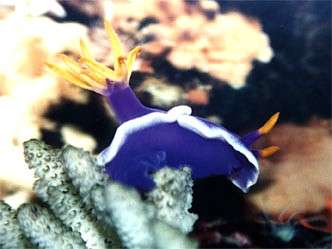
Bill:
Here is a message I received. Is this somebody you know? I doubt it would eat algae. You probably know the species.
"Hi Steve,
A couple weeks ago I bought a Neutebreanch at petland. They told me that he would eat algae and he is beautiful so I bought him. After watching him for a couple days I didn't notice him eating. I searched all over the internet but haven't found what he eats. I'm hoping you could tell me. Here is a
picture of him. Thank you for your help.
brie@gutboyz.com"
Regards,
Steve Long
miranda@oz.net
Long, S.J., 2000 (Jan 18) Hypselodoris bullocki again. [Message in] Sea Slug Forum. Australian Museum, Sydney. Available from http://www.seaslugforum.net/find/1747Dear Steve,
It is almost certainly Hypselodoris bullocki. I don't know whether the very blue colour is real or a result of the photography.
As you will see from the other information on this page, it is a sponge feeder. It is a shame that such beautiful animals are being collected to die in aquaria like this.
Best wishes,
Bill Rudman.
What does my nudibranch eat?
January 17, 2000
From: Laura Romin
We just purchased a bright pink nudibranch with orange tentacles and a white lateral line. What kind is it? And, what type of food should we provide for it. I understand that many nudibranchs require sponges but may be selective in the type of sponge they will accept.
Laura.
laura_romin@fws.gov
Romin, L., 2000 (Jan 17) What does my nudibranch eat?. [Message in] Sea Slug Forum. Australian Museum, Sydney. Available from http://www.seaslugforum.net/find/1741Dear Laura,
I'm afraid I would need some more clues before I could identify your nudibranch with any confidence. Any chance of a photo or even a drawing? Some idea of what part of the world it came from would also be of some help. There are hundreds, perhaps thousands of nudibranch species worldwide.
You are right in thinking that nudibranchs are very fussy feeders. Most have quite specific food requirements. Unfortunately, most of the animals they feed on - sponges, hydroids, bryozoans etc, - are also very difficult to keep alive in aquaria.
One possible guess at your nudibranch's identification would be Hypselodoris bullocki. If so, the white line would be the edge of the mantle skirt. If it is that species, have a look at the other messages below yours on this page for more information.
Best wishes,
Bill Rudman.
Information on Hypselodoris bullocki
October 6, 1999
From: Sophia Philipp
Dear Bill,
I have seen a nudibranch at Flinders Reef, Brisbane that seems to resemble C. bullocki (Neville Coleman's Nudibranchs of the South Pacific,1989). If you have any more information or other photos of it I would appreciate them. It may also help me to be able to distinguish it from other similarly coloured beasties if there are any.
Thank you,
Sophia Philipp
possum_sfp@hotmail.com
Philipp, S., 1999 (Oct 6) Information on Hypselodoris bullocki. [Message in] Sea Slug Forum. Australian Museum, Sydney. Available from http://www.seaslugforum.net/find/1401Dear Sophia,
The species is at present placed in the genus Hypselodoris rather than Chromodoris and there is a page for it, with most of the colour 'variants' already there. Also look below your message on this page for earlier messages about this species.
If you are looking for things in the Forum use the bottom (black) row of buttons on the navigation bar at the top of the page, or the list at the bottom of each page. Alternatively use the Search the Forum button which is either in the yellow bar at the top of each message or in the list at the bottom of the page.
If you have any other questions, or photos of some of your finds to share with us, please send them in. Even if we have a species illustrated already, I welcome further photos which help to show colour variation, new locality information or some biological fact like food, eggs etc.
Best wishes,
Bill Rudman.
What does my mystery slug eat?
July 15, 1999
From: Joel R.

Recently, I bought a purple sea slug ( with a single white band bordering the body, yellow gills, and "horns") at a local pet store in California (U.S.A.)
Since I don't have a photograph of it as of this moment, I have included in this message a jpg (which I drew using photoshop) of the slug.
I was wondering if you could help me identify:
1. what species it is?
2. (my main question) what it primarily eats?
Unfortunately, I have no idea where this particular species comes from; I hope the illustration helps, however. Thank you very much for your time.
Sincerely,
Joel R.
U.S.A.
jzruidera@earthlink.net
Ruidera, J., 1999 (Jul 15) What does my mystery slug eat?. [Message in] Sea Slug Forum. Australian Museum, Sydney. Available from http://www.seaslugforum.net/find/1070Dear Joel,
The slug is instantly recognisable from your great effort with Photoshop. If you have a look at the page on Hypselodoris bullocki you will find an almost identical animal in Photo E. At the moment we are considering this group of differently coloured animals to be colour forms of the one species, Hypselodoris bullocki, mainly because we can't find any anatomical differences which could be used to consider them different species.
I'm afraid there is not much likelihood of you finding a sponge that it will eat as most chromodorids are fairly choosy in their diets. I have a photo of one colour form feeding on a species of the sponge Dysidea. Other chromodorids feed on species of Aplysilla. There are species off both Dysidea and Aplysilla in Californian waters. You will need to find someone in California who can help you with sponge identifications, but it may be worth seeing if your nudibranch will eat them. I remember some years ago the endemic species of Rostanga in New Zealand, by some freak of biochemistry, was found to prefer an introduced sponge from Europe over all the native New Zealand sponges that it normally fed on.
Best wishes,
Bill Rudman.
Hypselodoris bullocki?
May 18, 1999
From: Glen Fishbaugh
I am the proud owner of a 90 gallon reef tank. The other day I saw a sea slug for sale at a local marine store. I have been unable to find any information on it. I looked in your species list. But the closest I could find was the Hypselodoris flavomarginata. I must tell you mine is a bright pink in color with yellow "horns". Have any idea which sea slug I might own? Better yet what it might eat?
Any information would be very helpful. Thank you for your time.
Glen Fishbaugh
gfishba1@rochester.rr.com
Fishbaugh, G., 1999 (May 18) Hypselodoris bullocki?. [Message in] Sea Slug Forum. Australian Museum, Sydney. Available from http://www.seaslugforum.net/find/869Dear Glen,
It sounds a bit like one of the 'species' or 'colour forms' I am calling Hypselodoris bullocki. Have a look at the photos I have of that species and let me know if any of them look like your animal. If it is that then it has a pretty restricted diet, feeding only on a few species of sponge. One of the photos has it on an unidentified species of Dysidea but I doubt if aquarium shops can supply identified sponges on order.
Best wishes,
Bill Rudman.
Hypselodoris bullocki laying eggs
May 7, 1999
From: Erwin Koehler

Bill,
Here is Hypselodoris bullocki with egg-mass dive-site Doljo, Panglao Is., Philippines, November 1998, size about 3 cm, 8 m
depth.
Erwin
Medslugs.Koehler@t-online
Koehler, E., 1999 (May 7) Hypselodoris bullocki laying eggs. [Message in] Sea Slug Forum. Australian Museum, Sydney. Available from http://www.seaslugforum.net/find/849Thanks Erwin,
Bill Rudman.
Hypselodoris bullocki
May 6, 1999
From: Jodi Hannahs
Chromodoris bullocki - Do you have any information on this species?
Jodi Hannahs
h2038@qtm.net
Hannahs, J., 1999 (May 6) Hypselodoris bullocki. [Message in] Sea Slug Forum. Australian Museum, Sydney. Available from http://www.seaslugforum.net/find/824Dear Jodi,
As you can see from the photos I have put at the Top of the Page, this species is either quite variable in colour or else there are a number of very closely related species which we have yet to sort out.
From anatomical studies this species is not a species of Chromodoris. It is usually considered a Hypselodoris but it has quite a few similarities to the genus Risbecia, so even its name isn't certain.
I'm afraid we don't know much about its biology either, other than it is a sponge feeder. I have photographed it feeding on an unidentified species of Dysidea, but that's about all I know about it. If anyone has more information and/or photos on any aspect of its biology, colour variation etc., I will be happy to add them to this page.
If you have any specific point you would like me to address Jodi, let me know and I will see what I can do.
Best wishes,
Bill Rudman.
